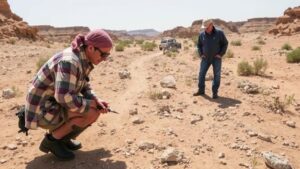Exploring Old Farmhouses for Buried Money Caches and Relics
Exploring Old Farmhouses for Buried Money Caches and Relics
The allure of discovering hidden treasures buried in old farmhouses is a captivating endeavor that combines history, archaeology, and adventure. As structures that often serve as repositories of stories and artifacts from the past, old farmhouses can provide valuable insights into the lives of those who once inhabited them. This article delves into the methods, techniques, and considerations involved in exploring these historic sites for buried money caches and relics.
Historical Context of Old Farmhouses
Old farmhouses are typically representative of agricultural life in their respective regions, often dating back to the 18th or 19th centuries. Many of these houses were built during a time of significant economic growth and social change, leading to various families accumulating wealth and property. In this context, it is not uncommon for farmhouses to have hidden treasures, owing to the tradition of burying valuables for safekeeping during periods of uncertainty.
Historic events, such as the Great Depression or wartime conflicts, often drove individuals to bury their money, jewelry, or other valuables. For example, during the Civil War in the United States, many families buried their personal belongings to protect them from looters. So, exploring old farmhouses not only serves as a hunt for artifacts but also as a journey through the rich tapestry of local history.
Techniques for Discovering Buried Treasures
When exploring old farmhouses for potential buried treasures, a combination of traditional research methods and modern technology can significantly enhance the likelihood of a successful discovery.
Researching Historical Ownership
The first step is to conduct thorough research on the farmhouse’s history and former occupants. Valuable resources include:
- Local historical societies
- County tax records
- Old maps and land deeds
- Family genealogies
Understanding who lived in the farmhouse and the context of their lives during significant historical events can provide clues about possible hidden treasures. For example, if records indicate a family faced financial hardship, it may suggest that they buried valuables in times of distress.
Using Metal Detectors
Metal detectors are essential tools when searching for buried caches. e devices can identify metal objects beneath the soil, which is particularly useful when searching for coins, jewelry, or other metallic artifacts. Different types of metal detectors offer various features tailored for different purposes. For example, some models are specifically designed for detecting coins at shallow depths, while others can locate deeper items, such as buried caches.
Ground Penetrating Radar (GPR)
For more advanced discoveries, Ground Penetrating Radar (GPR) can be employed. GPR technology allows for three-dimensional imaging of what lies beneath the surface, effectively identifying voids or anomalies that may indicate buried objects. This method has become common in archaeology and is valuable for detecting larger caches or structures without excavation.
Legal and Ethical Considerations
Exploring old farmhouses for buried treasures comes with legal and ethical responsibilities. Before embarking on a treasure hunt, it is vital to consider the following:
- Obtain permission from property owners.
- Familiarize yourself with local laws regarding treasure hunting and artifact collection.
- Practice ethical digging techniques that minimize damage to the site.
Ethics in treasure hunting ensures respect for historical contexts and prevents the loss or destruction of important archaeological information. As a case in point, a group of amateur treasure hunters once faced legal repercussions for excavating a site without permission, highlighting the importance of adhering to local regulations.
Documenting Finds
When treasures or relics are discovered, proper documentation is crucial. This includes:
- Recording the exact location of the find
- Taking photographs of the artifact and its context
- Writing detailed descriptions of the find, including any visible markings
Documenting finds can contribute to historical knowledge and provides important context for future excavations. In one notable example, an amateur archaeologist discovered a collection of colonial coins in Virginia and meticulously documented the circumstances of the find, contributing to the local community’s understanding of its economic history.
Real-World Applications and Case Studies
Various successful treasure hunts in old farmhouses have revealed intriguing historical artifacts. For example, in rural Wisconsin, a couple discovered a stash of gold coins dating back to the 1930s hidden within an old travel trunk found in their attic. Upon investigation, it became clear that the previous owner had hidden the coins during the Great Depression, reflecting the financial fears of that era.
Similarly, a team of archaeologists unearthed a range of artifacts, including tools and pottery, from beneath the floorboards of an old farmhouse in Massachusetts that dated back to the early 1800s. This find deepened the understanding of everyday life in that period, showcasing the importance of preservation and respectful excavation practices.
Conclusion
Exploring old farmhouses for buried money caches and relics presents a fascinating intersection of history, archaeology, and adventure. By employing effective research techniques, utilizing advanced technology, and adhering to ethical considerations, treasure hunters and historians alike can uncover invaluable artifacts that illuminate the lives of those who came before us. Whether driven by the thrill of discovery or a desire to preserve history, the findings in these pursuits contribute significantly to our understanding of the past and its narratives.
Actionable Takeaways
For those interested in exploring old farmhouses, consider the following steps:
- Conduct background research on the property’s history.
- Invest in quality metal detecting equipment if pursuing this hobby.
- Always seek permission before exploring a site.
- Prioritize ethical practices in artifact handling and site preservation.
Arming yourself with knowledge and respect for history may lead you to uncover treasures that not only hold monetary value but also shed light on the rich narratives of lives once lived.

